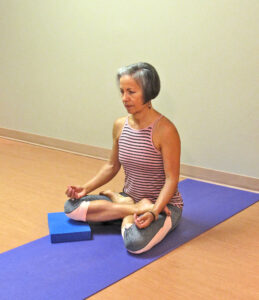Transformation occurs when we are able to expose our blind spots and release the unconscious but conditioned default patterns associated with them. The challenge is how do we become aware of what we don’t yet know about ourselves.
My last two blogs expanded on yoga teachings meant to help us with this unveiling. As I wrote most recently,
“Clear seeing + calm abiding = truth“ is a formula for both understanding what is driving one’s behaviour and then transforming the behaviour that no longer serves your wellbeing. In essence, if you want to know your truth, take your awareness to your inner experience. If you are not calm inside, then an inner war is ensuing, which reflects confusion and uncertainty, not confidence and clear seeing. If you are calm inside, then no inner battle is taking place between truth and delusion.
As both a social psychologist and yogi, I recognize that our ability to process our feelings in a healthy manner has everything to do with our wellbeing. Clinical psychologist, Douglas Tataryn, asserts healthy emotional processing, that is, clear seeing and calm abiding, is most likely to occur when we intimately understand our core feelings and can adequately express them. Interestingly, he further concludes
… there is no training, no language, no methods for adequately expressing them [core feelings] nor resolving them. In this emerging Post-Modern world, in which we struggle to communicate and know each other more deeply and intimately, we find ourselves unprepared and untrained to do so.
There is certainly evidence confirming this conclusion in most existing social systems — marriage, family, government, etc. As social beings, we are constantly relating to other human beings. In these everyday relationships is where we find ourselves either successfully communicating or unsuccessfully struggling and suffering. When we find ourselves struggling (not calm or clear), our default conditioned emotional reactions and underlying beliefs have been triggered by events in the relationship. Typically, these default emotional patterns are unconscious to us. They are our “blind-spots” and, thereby, bias our perceptions of people, things and events. Unfortunately, we tend to overreact when our blind-spots are triggered.
Fortunately, Tataryn has identified several relationship feelings, which are useful in uncovering one’s blind-spots. Here’s how I used a portion of his list to uncover a blind-spot in myself.
INSTRUCTIONS: Use a relationship you are currently struggling with as your focal point or context. It could be with a parent, child, sibling, lover, co-worker, friend, etc. Now repeat out loud, each of the following phrases and score each one according to your emotional and physical response.
If you find yourself moving into a story about one of the phrases, you have moved out of your emotions and body and into your intellect. As you may have already guessed, you are intellectualizing rather than feeling or sensing. So, return to your feelings and sensations. Score each phrase with the same answer scale.
I feel rejected
0 1 2 3 4 5 6 7 8 9 10
No I am crying or
activation really want to
I feel disappointed
I feel disrespected
I feel abused
I feel guilty
I feel ashamed
I feel abandoned
I feel ignored
I feel blamed
I feel betrayed
Given the relationship you chose as your context, if more than one feeling is triggered, choose the highest score. You may find it helpful to complete the feeling belief phrase by writing a descriptive statement that expands on your context.
Once you are more fully aware of the feeling triggered in you, ask yourself “Am I calmly and clearly seeing the truth in my context?” or “Am I overreacting to someone who is doing the best they can given the moment in time?”
In my own case, I immediately realized one of my feeling triggers is “abuse.” As my reflection deepened, I also realized I can best manage myself by practising non-reaction (detachment) in such situations rather than taking others’ comments personally (an old default pattern). Finally, the real measure of my answers’ truthfulness was my inner state of calm.





